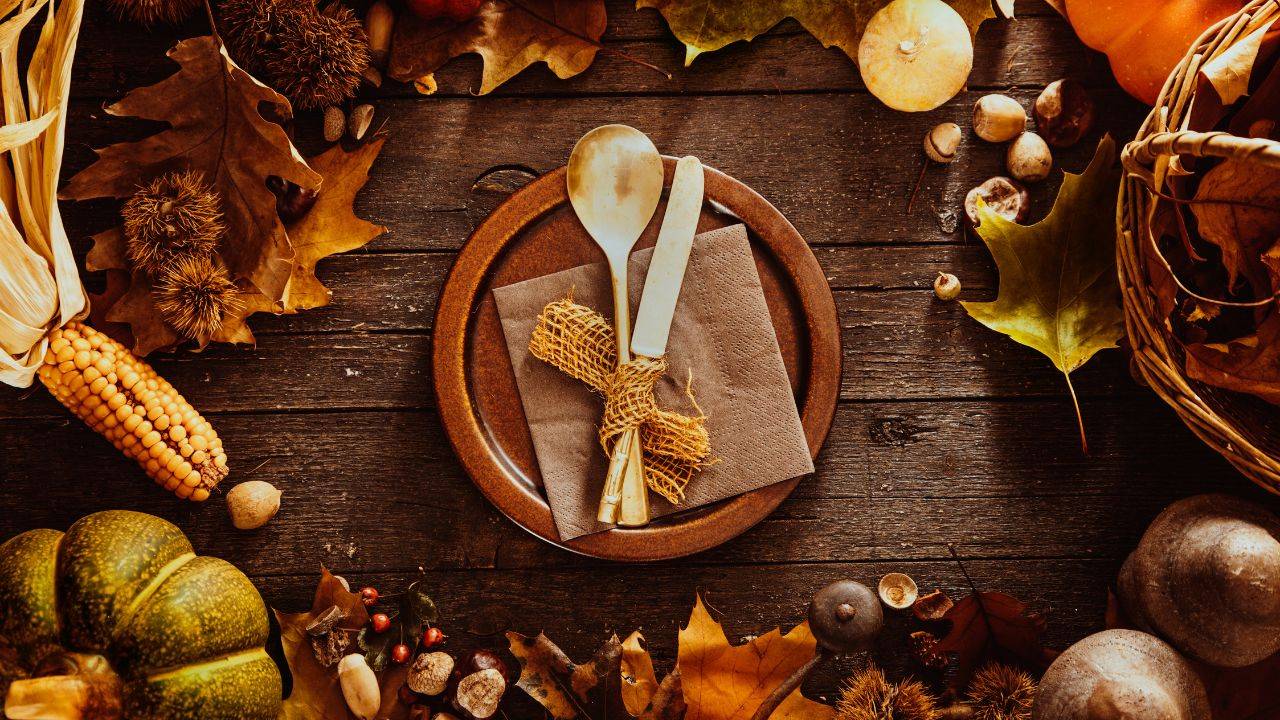Being a Thanksgiving party host is a blessing. You get to bring all of your loved ones under one roof and create an atmosphere of joy, happiness, and best of all — thankfulness.
But we often forget about one thing, Mother Nature.
Can you imagine that we toss out about 200 million tons of turkey only during Thanksgiving?
Plus, think about all the plastic cutlery!
It’s high time we put a stop to all these and think about having a sustainable Thanksgiving dinner. In this guide, I’ll explore different Thanksgiving party planning ideas. Hopefully, as a host, you can make some true changes this year.
Why Bother About Sustainable Thanksgiving Party Planning?
The amount of waste created during Thanksgiving is staggering.
According to the National Environmental Education Foundation (NEEF), Americans produce 25% more waste between Thanksgiving and New Year’s Day. The majority of that waste comes from food, and this takes a huge toll on the environment.
Here are some facts to help you get a clearer picture of Thanksgiving waste.
While there are different kinds of waste created on Thanksgiving, food waste is the most worrying.
$293 million is wasted in food only during Thanksgiving!
Food is the largest waste category in municipal landfills during the holiday season.
This is especially worrying because food releases greenhouse gases as it decomposes, especially methane, which is a very potent gas.
Most of that food is produced by animals. Animals produce 369 million tons of manure on the largest animal farms. Most manure is stored in open ponds, where it contributes to land, water, and air pollution.
Here’s how much other traditional food is used during Thanksgiving:
- Turkey — 42 million turkeys are bought, and 6 million turkeys are tossed out after Thanksgiving. This amounts to 200 million pounds of turkey.
- Potatoes — 250 million pounds of potatoes are bought, and 40 million pounds of mashed potatoes end up in a trash can.
- Ham — 77 million pounds of ham are bought.
- Stuffing — 30 million pounds of stuffing are thrown out.
- Pies — 28 million pies are sold.
- Rolls — 40.5 million rolls are sold.
- Sweet potatoes — 57 million pounds are sold.
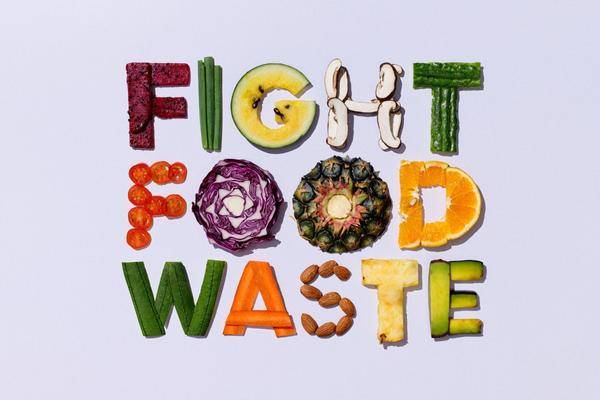
Also, we need to think about the “food miles.”
Potatoes, turkeys, and cranberries often travel 1,500 to 2,000 miles from the farm to the table, which is three times more than an average American guest travels. These are called food miles, and the fuel they spend also goes into the resources used when you make a meal.
13 Sustainable Thanksgiving Celebration Tips for the Hosts
Even if you swap just one thing you usually do for Thanksgiving with a sustainable option, it’ll make a huge difference across the country.
Here are some ideas on how to have a more sustainable Thanksgiving.
1. Save a Turkey
Livestock farming is one of the biggest polluters. The higher up in the food chain you go, the more resources you consume. This is why many people decide to cut the turkey altogether from Thanksgiving.
If you decide not to serve turkey, you can go for tofu or a turkey substitute. Vegetarians in your family will especially appreciate this.
You can even go a step further and adopt a turkey. Check for farm sanctuaries that rescue animals. This could even be a new Thanksgiving tradition.
If you aren’t ready to skip the turkey, or your family won’t let you, that’s alright. There are other options to consider. Buy a local turkey from a small producer instead of a turkey from a large farming company. Small local producers usually raise them in more humane conditions.
Also, don’t buy just any turkey. Instead, choose one of these: local and pasture-raised, heirloom and heritage, organic and non-GMO.
Pro Tip: Even if you have a turkey for Thanksgiving, you can be more mindful with your food the rest of the year and eat food that’s lower on the food chain.
2. Shop Your Fridge
We tend to overbuy during the holidays because of tempting sales and poor planning. Don’t be carried away by supermarket sales and coupons.
Before you go shopping, do a thorough inventory of your fridge and pantry. That way, you won’t find yourself in the middle of the canned goods aisle wondering if you have enough beans and buying a couple of cans “just to be sure.”
According to The U.S. Environmental Protection Agency (EPA), you should check what you already have in your home before going to the store. Reach all the way back on your shelves to find those cans you’ve forgotten all about.
3. Buy Locally
Once you take a thorough inventory of the food already in your home, it’s time to go shopping.
Buying locally grown veggies will have less impact on the environment, and you’ll probably end up with better-tasting food.
Seasonal fall food includes sweet potatoes, carrots, pumpkins, apples, and many more. You can serve them in many different ways, such as the traditional pumpkin pie, apple cider, and more.
You can get all these from the farmers’ market. This will cut down on both your and veggies’ carbon footprint. Plus, you’ll support a family farm.
Not to mention that locally grown veggies will be fresher because they didn’t travel a thousand miles to get to you.
If there’s no farmers market close to you, choose foods in the grocery store that are organic. Whole Foods Thanksgiving offer is always plentiful.
You can do the same for drinks. Go for vegan options, such as vegan wine, and support a local brand.
Finally, skip produce bags, but take your own shopping bags when you do the Thanksgiving shopping.
4. Use Water Responsibly
Americans use a lot of water in general, but especially on Thanksgiving. Think about all the cooking, the washing of hands, the washing of dishes, and of course, the drinking of all the water that happens on this day.
We need to conserve water.
A good rule to follow is only to have the tap running when you have to use it. Don’t leave it open while you go grab another plate to wash.
Also, stay clear of bottled water. Plastic bottles leach chemicals, plus they create a ton of waste. Instead, serve tap water and get a faucet filter for the best quality.
5. Be Economical With Side Dishes
Think about how many side dishes you really need. Do you have that one side dish that sits at the end of the table and end up being almost untouched?
Don’t waste resources on side dishes that you don’t really need. For example, you don’t need three different pies or three potato-based dishes. Narrow it down to your most popular side dishes, or make one that uses locally grown ingredients.
Once again, if this isn’t an option, go for organic food.

6. Plan What Each Guest Should Bring
If you’re having guests for Thanksgiving, and they are bringing dishes to the feast, coordinate with them.
Check what everyone plans on bringing. This way, you’ll avoid making too much food or even duplicating someone else’s dish.
7. Make Food From Scratch
83% of food greenhouse gas emissions come from the production of food.
When you’re shopping, choose food that’s less prepared and packaged. This will lower your carbon footprint, and you’ll end up with healthier food with less sugar.
If you’re worried about your cooking skills, ask your mom or grandma for a helping hand and make it a family effort.
8. Serve Food on Reusable Dishes
If you’re struggling to decide whether to serve food on paper, plastic, or china, the best option is always reusable dishes.
I know doing the dishes is annoying, but it’s better than sending paper plates to a landfill.
Plus, you can use a dishwasher. The good news is many modern dishwashers use fewer resources than washing by hand.
But if you don’t want to bring out your best china, go for biodegradable paper plates that you can later compost.
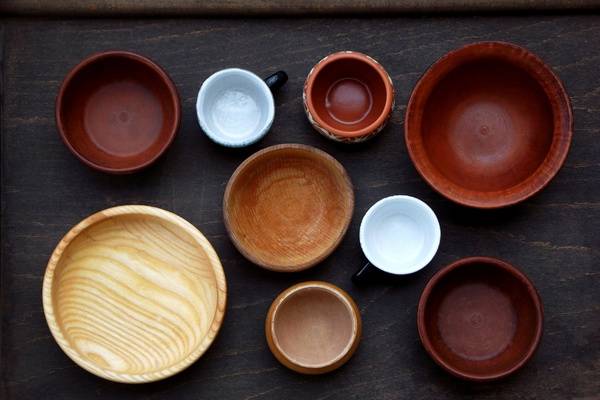
9. Get Reusable Containers
If you’re sharing the leftover food with family and friends, stay away from plastic containers for leftovers. Instead, think ahead about what you’re going to store, and then choose eco-friendly options.
Go for glass to-go containers or compostable to-go containers. This way, your guests will be able to give the containers back to you, reuse them, or compost them.
10. Get Sustainable Decor
Thanksgiving decor will elevate the holiday feel. This is another area where you can have a sustainable Thanksgiving.
Buy some flowers, use vintage dinnerware and glassware.
If you’re feeling creative, make some decorations of your own. You can even upcycle some old items around your home. For example, use a wine bottle as a vase.
If you have a backyard, get some fallen leaves to decorate the table. Collect pine branches and pinecones. These will be fragrant, and after Thanksgiving, you can compost them or give them back to nature.
In case you decide to buy some decorations, avoid plastic. Instead, go to your local thrift store and see what autumnal treasures you can find there.
You can also shop sustainable and ethically-made products on Etsy.
11. Use the Leftovers
Don’t scrape the leftovers into the garbage. Instead, start eating with smaller portions, and eat with your stomach, not your eyes.
Then, put the leftovers to good use. Give them to friends and family or use them in other recipes.
If you can’t stomach the idea of more Thanksgiving food, put the leftovers in the freezer. I guarantee you’ll be happy about it in several weeks or months.
Finally, you can compost the leftovers. This compost can be used to grow your own fruits and veggies.
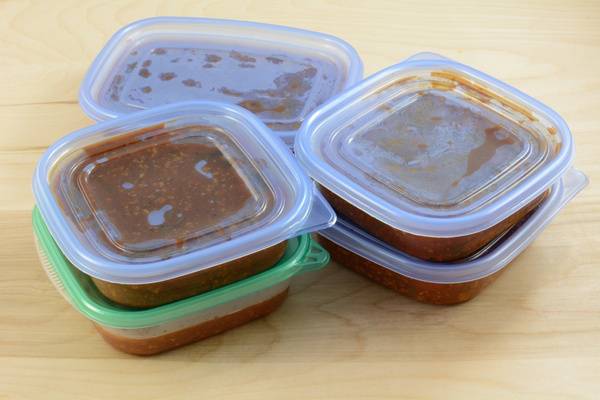
12. Donate
One of the best ways to give thanks is to donate to those who are less fortunate.
You can give your leftover food to local food banks and shelters. However, keep in mind that these places get overloaded during the holidays. First, call and check if they need more food.
You can also donate to a group such as Meals on Wheels, which maybe won’t receive as many donations as food banks and shelters.
13. Travel Responsibly
The days before and after Thanksgiving are historically the busiest travel days in the US.
31.6 million people used air travel last year only.
If you can, use public transportation, carpool, or shorten the list of places you’ll go to on Thanksgiving.
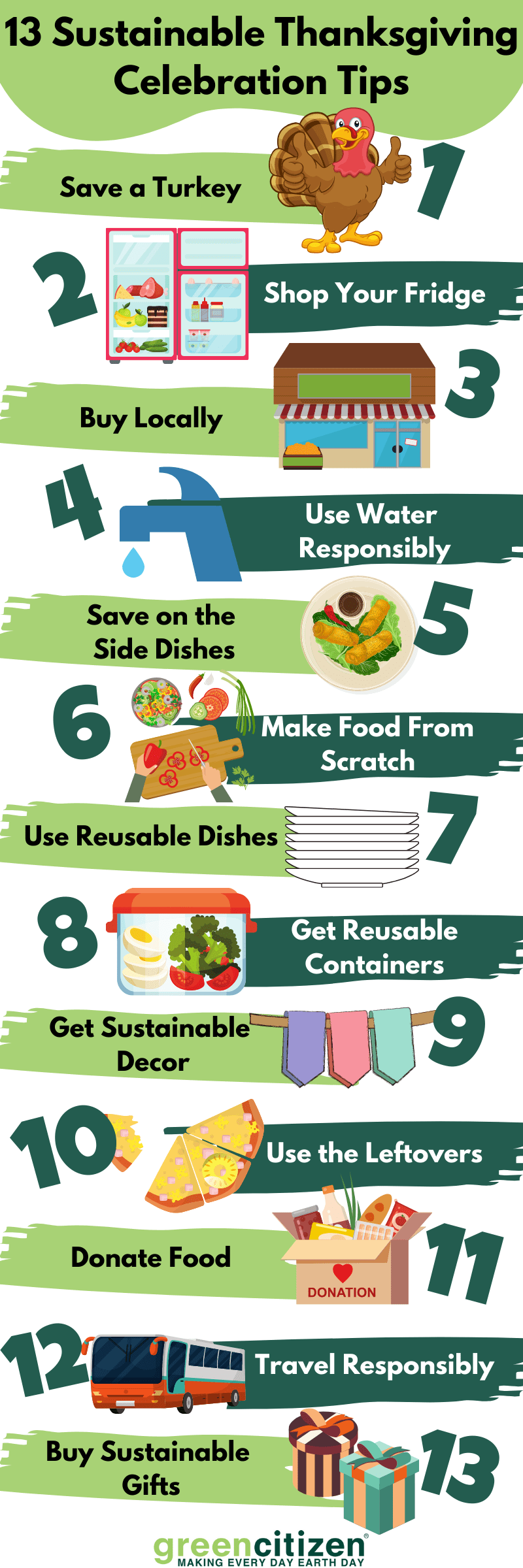
Let’s Have a Sustainable Thanksgiving This Year!
Holidays are the best but also the most wasteful part of the year.
40% of Thanksgiving food goes to waste, and Thanksgiving gifts and travel also harm our environment. If every household swapped one dish, we would make a huge impact and have a more sustainable Thanksgiving.
So, this year, try to make responsible choices. Shop locally, cook responsibly, and donate your leftovers.
If you can, lower your travel emissions, and buy eco-friendly Thanksgiving gifts.
This is the best way to say thanks to the home we all share — our beautiful planet.

